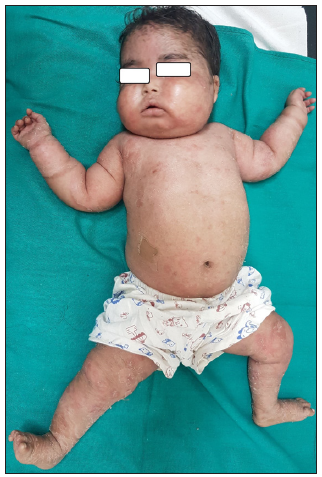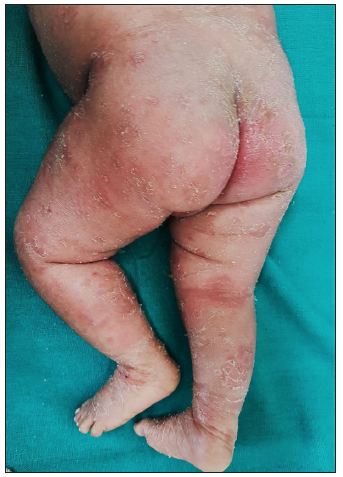Translate this page into:
Iatrogenic cushing’s syndrome following potent topical steroid application in an infant
*Corresponding author: Archana Singal, Department of Dermatology, UCMS and GTBH, Law apartment, Karkardooma, Delhi, India. Email: archanasingal@gmail.com
-
Received: ,
Accepted: ,
How to cite this article: Agrawal S, Singal A. Iatrogenic cushing’s syndrome following potent topical steroid application in an infant. Ann Natl Acad Med Sci (India) 2024;60:297-8. doi: 10.25259/ANAMS_72_2024
Dear Editor,
Iatrogenic Cushing syndrome in children is an expected side effect of systemic corticosteroid use for autoimmune disorders. However, misuse and overuse of inhaled or topically applied steroid cream in young children may be rarely associated with systemic absorption, leading to hypothalamic-pituitary-adrenal (HPA) axis dysfunction and complications like Cushing syndrome.1,2
A 9-month-old male child was brought with the generalized scaly lesions of 3 months duration. The infant was of 3rd order, born to non-consanguineous parents by normal vaginal delivery, adequately vaccinated and with normal milestones for age. Three months ago, the mother noticed a small ring-shaped lesion on his lower abdomen for which she applied a topical fixed drug combination (FDC) containing Clobetasol Topical 0.05%w/w, Miconazole Topical 2%w/w and Neomycin 0.5%w/w twice daily. The initial partial response was followed by a sudden increase in the size and extent of lesions that became generalized within 6 weeks. Approximately 80 g of this formulation was used. The child gained excess weight with a puffy face, irritability, and lethargy. Mother had been self-medicating with similar FDC for extensive fungal infection for 6 months. Physical examination revealed an obese baby with overall poor hygiene, generalized scaling, and cushingoid features (facial puffing, buffalo hump, facial erythema, and telangiectasias, distorted ears [Figures 1 and 2]. His weight and height were 9.8 kg and 66 cm, respectively, with normal blood pressure. Direct microscopic examination of skin scrapings in 10% KOH revealed branching septate hyphae and culture T. mentagrophytes complex. Similar results were obtained from the lesions in the mother. Morning serum cortisol levels of the infant revealed low levels of 0.67 µg/mL (normal 7–25 µg/mL). The rest of the investigations were within normal range except for low serum vitamin D level (13 ng/mL). A diagnosis of erythroderma secondary to extensive dermatophytosis with iatrogenic Cushing syndrome was made. Both mother and infant were prescribed 1% clotrimazole for topically with systemic antifungals.

- A 9-month-old male infant with cushingoid features and erythroderma due to dermatophytosis.

- Generalized dermatophytosis (erythroderma) involving entire body.
India is witnessing an unprecedented increase in the cases of superficial dermatophytosis.3 There has been a dramatic clinico-epidemiological shift with the affection of children and young adults, atypical clinical manifestations, transition of an etiological agent from Trichophyton rubrum (T.rubrum) to T. mentagrophytes complex and emerging antifungal resistance.4 Use of the over-the-counter available potent topical steroid (Clobetasol Topical 0.05%) containing FDCs has been considered the major responsible factor for this change.5
Cushing syndrome is an endocrinological disorder characterized by increased free plasma glucocorticoid levels, either due to an excessive endogenous release of steroids or exogenous administration. In children, iatrogenic Cushing syndrome is relatively common secondary to oral/parenteral steroids prescribed for renal, hematological or autoimmune pathology. However, percutaneous absorption of potent topical steroids used for a long time rarely causes Cushing syndrome in young children. There have been few reports of iatrogenic Cushing syndrome secondary to the use of topical clobetasol propionate ointment for inappropriate indications such as diaper dermatitis.1,2
Education of the pharmacist, parents, and physicians about the use of low-potency steroids for a limited duration may be a worthy exercise in preventing these complications.
Ethical approval
Institutional Review Board approval is not required.
Declaration of patient consent
The authors certify that they have obtained all appropriate patient consent.
Financial support and sponsorship
Nil.
Conflicts of interest
Dr. Archana Singal is on the Editorial Board of the Journal.
Use of artificial intelligence (AI)-assisted technology for manuscript preparation
The authors confirm that there was no use of artificial intelligence (AI)-assisted technology for assisting in the writing or editing of the manuscript and no images were manipulated using AI.
References
- An infantile Cushing syndrome due to misuse of topical steroids. Pediatric Dermatology. 2004;21:561-3.
- [CrossRef] [PubMed] [Google Scholar]
- Two cases of Cushing’s syndrome due to overuse of topical steroid in the diaper area. Pediatr Dermatol. 2008;25:544-7.
- [CrossRef] [PubMed] [Google Scholar]
- The unprecedented epidemic-like scenario of dermatophytosis in India: I. Epidemiology, risk factors and clinical features. Indian J Dermatol Venereol Leprol. 2021;87:154-75.
- [CrossRef] [PubMed] [Google Scholar]
- Tinea pseudoimbricata as a unique manifestation of steroid abuse: A clinico-mycological and dermoscopic study from a tertiary care hospital. Indian Dermatol Online J. 2019;10:422-5.
- [CrossRef] [PubMed] [PubMed Central] [Google Scholar]
- Iatrogenic Cushing’s syndrome in patients with superficial dermatophytosis. Indian Dermatol Online J. 2021;12:237-43.
- [CrossRef] [PubMed] [PubMed Central] [Google Scholar]




